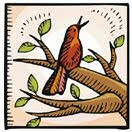White pines, scarlet and red oaks, and bald cypress compared
Because of their size, trees can absorb a lot of carbon dioxide, a greenhouse gas produced by nature and by man's activities.
U.S. Forest Service researcher Dave Nowak lists the following trees as some of the best for soaking up Co2: "the Common Horse-chestnut, Black Walnut, American Sweetgum, Ponderosa Pine, Red Pine, White Pine, London Plane, Hispaniolan Pine, Douglas Fir, Scarlet Oak, Red Oak, Virginia Live Oak and Bald Cypress..."
 |
| Sweetgum female & male fruits, leaf |
All of these are big trees, so you'd need plenty of room to plant any of them as a lawn tree. I wouldn't recommend the black walnut if you keep a well-manicured lawn. The nuts are a mess unless you really dedicate yourself to picking them up. The prickly seed-balls of the sweetgum could also be a problem. They can blunt lawn mower blades and hurt bare feet.
The bald cypress is the longest-lived tree in this group of Kentucky natives. It can live up to a thousand years or even more in ideal circumstances. It likes damp areas, and it will develop knees if its roots are able to reach water. However, it will tolerate dryer spots if water is provided during long spells of hot, dry weather. It holds up well to wind and ice, but it doesn't do well in alkaline soils. Its wildlife value is very low.
The oaks will be beautiful, weather-resistant trees, and scarlet and red oaks are fast-growing compared to some oaks, adding up to two feet a year to their height. Their acorns are a great food source for birds, squirrels, and other small and large animals. They may live for a couple of centuries in a good site. You will have to watch them for insect infestations, wilts, etc. and perhaps do some spraying. The northern red oak will endure more air pollution than the scarlet oak. Neither tree will do well in compacted soil.
 |
| White pine needles and cone |
White pines are also great trees for wildlife, and they are attractive and weather resistant. They could easily live 200-300 years in good growing conditions. Their growth rate is similar to the red and scarlet oaks, up to 2 feet per year. White pines don't thrive in areas of heavy air pollution and they also don't like salt, compacted soil, or excessive drought and heat. They definitely wouldn't be a good tree to plant along a busy highway.
If I were going to plant one of these trees, I'd choose one of the oaks!
- - - - - - - - - -
 To make this comparison, I consulted Native Trees, Shrubs, and Vines for Urban and Rural America: A Planting Design Manual for Environmental Designers, by Gary L. Hightshoe. Published by Van Rostrund Reinhold, New York, in 1988.
To make this comparison, I consulted Native Trees, Shrubs, and Vines for Urban and Rural America: A Planting Design Manual for Environmental Designers, by Gary L. Hightshoe. Published by Van Rostrund Reinhold, New York, in 1988.

 "The power to recognize trees at a glance without examining their leaves or flowers or fruit as they are seen, for example, from the car-window during a railroad journey, can only be acquired by studying them as they grow under all possible conditions over wide areas of territory. Such an attainment may not have much practical value, but once acquired it gives to the possessor a good deal of pleasure which is denied to less fortunate travelers."
"The power to recognize trees at a glance without examining their leaves or flowers or fruit as they are seen, for example, from the car-window during a railroad journey, can only be acquired by studying them as they grow under all possible conditions over wide areas of territory. Such an attainment may not have much practical value, but once acquired it gives to the possessor a good deal of pleasure which is denied to less fortunate travelers."
2 comments -- please add yours:
Me? I'd plant lots of bald cypress. I have plenty of oaks in my forest already. Even a few walnuts here and there.
Thanks for your comment, Paul. You know, bald cypress is a great tree in many ways, but personally, I favor the oaks because of their great wildlife value. Well, to be honest, I just like oaks. :D
Post a Comment